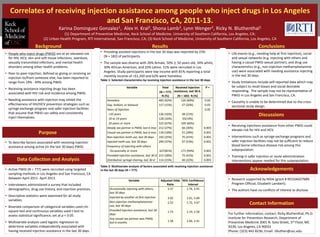
Correlates Receiving Injection Help PWID LA SF 2011-13
- 1. Correlates of receiving injection assistance among people who inject drugs in Los Angeles and San Francisco, CA, 2011-13. Karina Dominguez Gonzalez1, Alex H. Kral2, Shona Lamb3, Lynn Wenger2, Ricky N. Bluthenthal1 (1) Department of Preventive Medicine, Keck School of Medicine, University of Southern California, Los Angeles, CA; (2) Urban Health Program, RTI International, San Francisco, CA; (3) Keck School of Medicine, University of Southern California, Los Angeles, CA • Active PWID (N = 777) were recruited using targeted sampling methods in Los Angeles and San Francisco, CA between April 2011- April 2013. • Interviewers administered a survey that included demographics, drug use history, and injection practices. • Descriptive statistics were examined for all study variables. • Bivariate comparison of categorical variables used chi- square test and continuous variables used t-test to assess statistical significance, set at p < 0.05. • Multivariate analysis used logistic regression to determine variables independently associated with having received injection assistance in the last 30 days. Background Purpose Results Discussions • People who inject drugs (PWID) are at an elevated risk for HIV, HCV, skin and soft tissue infections, overdose, sexually transmitted infections, and mental health disorders among other health problems. • Peer-to-peer injection, defined as giving or receiving an injection to/from someone else, has been reported to range from 19% - 49% among PWID. • Receiving assistance injecting drugs has been associated with HIV risk and incidence among PWID. • Needing assistance with injection may inhibit the effectiveness of HIV/HCV prevention strategies such as syringe exchange program and safer injection facilities that assume that PWID can safely and consistently inject themselves. • To describe factors associated with receiving injection assistance among active (in the last 30 days) PWID. • Receiving injections assistance from other PWID could elevate risk for HIV and HCV. • Interventions such as syringe exchange programs and safer injection facilities may not be sufficient to reduce blood borne infectious disease risk among this subpopulation. • Training in safer injection or route administration interventions appear needed for this subpopulation. Conclusions • Life events (e.g., needing help at first injection), social and sexual networks (e.g. injecting with others and having a casual PWID sexual partner), and drug use characteristics (e.g., non-injection methamphetamine use) were associated with needing assistance injecting in the last 30 days. • Study limitations include self-reported data which may be subject to recall biases and social desirable responding. The sample may not be representative of PWID in Los Angeles and San Francisco, CA. • Causality is unable to be determined due to the cross- sectional study design. • Providing assisted injections in the last 30 days was reported by 23% (N = 182) of participants. • The sample was diverse with 26% female, 50% ≥ 50 years old, 34% white, 30% African American, and 25% Latino. 51% were recruited in Los Angeles. Study participants were low income with 81% reporting a total monthly income of <$1,350 and 62% were homeless. Table 1: Selected characteristics by receiving injection assistance in the last 30 days. Table 2: Multivariate analysis of factors associated with receiving injection assistance in the last 30 days (N = 777). For further information, contact: Ricky Bluthenthal, Ph.D. Institute for Prevention Research, Department of Preventive Medicine 2001 N. Soto Street, 3rd Floor, MC 9239, Los Angeles, CA 90033 Phone: (323) 442-8236; Email: rbluthen@usc.edu Acknowledgements Contact Information • Research supported by NIDA (grant # RO1DA027689: Program Official, Elizabeth Lambert). • The authors have no conflicts of interest to disclose. Variable Adjusted Odds Ratio 95% Confidence Interval Occasionally injecting with others, last 30 days Injected by another at first injection Non-injection methamphetamine use, last 30 days Provided injection assistance, last 30 days Any casual sex partner was PWID, last 6 months 3.37 3.02 2.52 1.73 1.58 1.74, 2.41 1.61, 5.68 1.72, 3.67 1.19, 2.50 1.04, 2.41 Data Collection and Analysis Variable Total (N = 777) N (%) Received injection assistance, last 30 d. (N = 182) N (%) P = Homeless Gay, lesbian, or bisexual Years of injection <10 years 10 to 19 years 20 years or more Steady sex partner is PWID, last 6 mos Casual sex partner is PWID, last 6 mos Non-injection meth use, last 30 days Injected meth use, last 30 days Frequency of injecting with others Occasionally or more Provided injection assistance, last 30 d Distributive syringe sharing, last 30 d 483 (62%) 117 (15%) 126 (16%) 128 (16%) 522 (67%) 212 (27%) 139 (18%) 192 (25%) 290 (37%) 627(81%) 215 (28%) 114 (15%) 126 (69%) 37 (20%) 38 (21%) 35(19%) 109 (60%) 66 (36%) 51 (28%) 75 (41%) 97 (53%) 171 (94%) 75 (41%) 40 (22%) 0.02 0.03 0.05 0.003 0.001 0.001 0.001 0.001 0.001 0.003